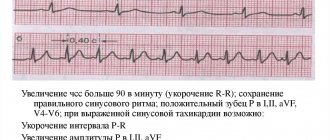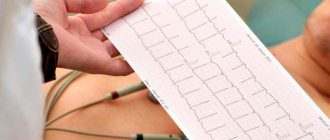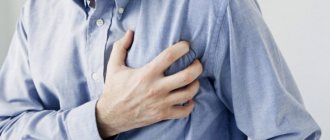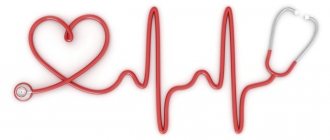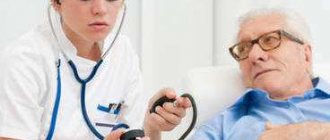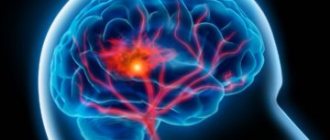Symptoms of the pathological condition
The combination of symptoms described is similar to signs of poisoning. These include:
- nausea;
- vomiting, which may contain blood clots;
- sharp pain, especially in the upper abdomen;
- headache;
- feeling of squeezing in the chest.
That is why the patient tries to remember all his recent meals in order to confirm the diagnosis. However, these signals may indicate another, more serious disease.
Possible localization of pain in heart disease
Causes of illness, their etiology and characteristics
Dizziness and headaches can be localized in any part of the head: temporal, occipital or frontal. This may cause stomach pain, nausea, and loss of vision or hearing. These are signs of pathologies of different organs or even entire systems of the body.
The main diseases with these symptoms include:
- angina pectoris;
- hypertensive crisis;
- heart attack;
- vegetative-vascular dystonia;
- cardiac ischemia;
- heart failure;
- pneumonia or bronchitis in advanced form;
- liver or pancreas diseases.
With angina, the patient feels pain in the heart and tightness in the chest. Often this disease is accompanied by a change in skin color to pale, hands become cold, and sweat appears on the forehead. Causes of malaise: hypertension, overwork, stress, being in a cold or stuffy room.
Hypertensive crisis is a disease in which there is a sharp rise in blood pressure. Symptoms: pressing and aching pain in the heart, dizziness and nausea with vomiting.
What happens in the body when blood pressure rises?
Heart attack. Nausea, loss of consciousness, acute, “dagger” heart pain, shortness of breath, fainting, panic, trembling and weakness - these are all signs of a heart attack. It happens that a terrible attack does not manifest itself in any way, and only a feeling of nausea can signal it.
There is another type of heart attack - gastric (abdominal) heart attack, to which women are more susceptible. In this case, the victim has severe pain in the stomach area, which hides the heart pain.
The symptoms of a gastric infarction are somewhat different from the symptoms of a regular infarction and appear as follows:
- the stomach suddenly begins to hurt (with gastrointestinal diseases, the pain appears gradually);
- pain increases quickly and reaches an extreme point;
- pain does not depend on food intake;
- vomiting does not improve the patient’s well-being;
- Most likely, the victim had previously been diagnosed with angina pectoris.
Heart attack
Vegetative-vascular dystonia is an ambiguous disease; such a diagnosis is made only in our country. Abroad, this disease is not recognized, and dystonia is considered only a symptom of other ailments. If the autonomic nervous system does not function properly, the patient may not sleep at night and suffer from rapid heartbeat and pressure changes. Dizziness, heart pain and nausea also indicate this problem.
The reasons for this condition are stress and changes in psycho-emotional stress. Complications of vegetative-vascular dystonia have not yet been identified, however, the disease should not be underestimated and it is better to consult a doctor, since VSD is associated with the state of the nervous system, and proper therapy will not cause harm.
How to recognize VSD by indirect signs
Coronary heart disease is a disease in which the heart does not receive the amount of blood necessary for normal functioning. In this case, the patient experiences abnormal heartbeat, shortness of breath, nausea and, as a result, vomiting, weakness and increased sweating, especially on the forehead. The patient may confuse the symptoms with gastrointestinal diseases, since the pain is similar to heartburn.
With heart failure, a nagging pain in the heart area and nausea appear. The causes of the disease are caused by disturbances in the structure of the muscle tissue of the heart, increased pressure inside the chambers of the heart, stagnation of blood in the vessels and the development of pulmonary edema. This is why a person feels nauseous.
Insufficiency of the pumping function of the heart can be expressed in constipation, flatulence and bouts of vomiting. The causes of the disease are as follows:
- improper functioning of the digestive organs due to lack of oxygen;
- overdose or improper use of medications.
Pneumonia or bronchitis. Heart pain and nausea are a sign not only of diseases of the heart apparatus, but also of the lower parts of the human respiratory system. The pain appears due to a strong “clogging” cough. In this case, the patient complains of chills, severe cough, nausea, runny nose, fever and sweating. It is the temperature, runny nose and chills that indicate respiratory disease.
Diseases of the liver or pancreas. In this case, the patient has pain in the heart area, he feels nauseous, but does not vomit. Unpleasant sensations may also be observed under the ribs. If the gallbladder does not work properly in the mouth, there is a feeling of bitterness in the mouth.
Why does it freeze under pressure?
The state of chills is a clear representative of ongoing problems in the body, especially when it freezes under pressure.
This symptom is most often found in combination with general malaise and weakness, a persistent need for rest and a clear decrease in work activity.
Chills can also occur in case of hypothermia, being an absolutely natural reaction aimed at warming the body due to spontaneous tension of its muscular layer.
The mechanism of development of the body's reaction
When the patient gets a chill, and the body temperature parameters are not increased, the muscular layer of the body begins to contract spasmodically, spreading tremors, which first manifests itself in the masticatory muscle, and then throughout the body.
In terms of ongoing internal reactions, there is a sharp increase in glucose content in the bloodstream with rapid breakdown of fat cells against the background of adrenaline synthesis. In such conditions, the temperature in the body decreases, forcing you to feel cold with the occurrence of trembling that covers the entire body.
Associated signs of chills in hypertension
The condition when a person begins to freeze with high blood pressure is accompanied by the manifestation of the following accompanying symptoms:
- heartbeats increase sharply;
- a burning wave of heat is felt spreading throughout the body;
- background noise appears in the ears.
A state of chills with high blood pressure may indicate the development of a hypertensive crisis, which is accompanied by a violation of the general blood flow against the background of changes in the state of the vascular network.
Carrying out therapeutic actions that allow you to normalize the level of pressure, effectively eliminating signs of trembling. In some cases, the sensation of shivering with pressure is an indicator of a serious functional disorder in the urinary system or the activity of the thyroid organ.
How dangerous is a critical condition?
If fluctuations are detected and vascular pressure readings are not monitored, it may spontaneously increase, as indicated by the appearance of trembling. This condition is dangerous due to rupture of the tissues of the vascular network with the formation of focal hemorrhages and stroke. The consequences may be:
- rapid development of atherosclerosis of blood vessels and aorta;
- the formation of plaques on their walls;
- narrowing of the vascular lumen and thickening of the walls, which become less elastic;
- changes in microcirculation of blood flow in the main internal structures of the body.
Ways to normalize the condition
When the patient freezes with blood pressure and its limits do not decrease, it is necessary to seek on-site emergency care at a medical institution. Before the specialists arrive, the patient should lie down or sit comfortably. This opportunity will prevent the development of suffocation, and an open window will allow oxygen to saturate the body tissues during the breathing process.
Providing assistance includes performing the following manipulations:
- For combined pain in the heart, take a validol tablet or a Corvalol solution.
- Warm the lower extremities using a blanket, warm socks or a heating pad.
- Place the patient's feet on a towel soaked in a solution of apple cider vinegar, and a decrease in pressure is observed with the trembling subsiding within 10 minutes after the start of the procedure.
If chills are a sign of the development of a hypertensive crisis, it is recommended to take drotaverine or no-shpu, then valocordin. After taking medications, you need to sit comfortably and try to relax as much as possible; the trembling will gradually go away as the pressure limits normalize.
Why does one tremble during hypotension?
The occurrence of chills with a decrease in vascular pressure parameters most often appears in combination with the following symptoms:
- nausea and vomiting;
- weakness and dizziness;
- sudden sweating;
- intense secretion of saliva and involuntary swallowing movements.
The developing state of lethargy and weakness begins to provoke the development of tremors. With this reaction, the body tries to independently increase the pressure of the blood flow in the vascular bed. The observed vasospasm leads to its intensification, but with a significant decrease in pressure indicators, it requires the implementation of therapeutic and preventive procedures.
A state of chills may appear at low pressure limits in the vascular network due to overwork or after an infection, be a consequence of skull injuries or a complication of endocrine pathology, as well as other sluggish processes in the body.
Sequence of rehabilitation actions
In case it freezes at low pressure, it is recommended to do the following:
- Taking medications with the main component of caffeine, ergotamine, ditamine or dopamine, the dosage and type of which are prescribed by the treating specialist after a thorough examination.
- Herbal preparations: tincture of Eleutherococcus, ginseng, Schisandra chinensis.
- Normalization of sleep and wakefulness intervals.
- Maintaining a balance in the diet.
- Daily walks and moderate exercise.
If trembling is detected in the body, it is necessary to initially measure the temperature parameters and pressure level, and then begin therapeutic correction of the condition.
Source: https://serdcenebolit.com/morozit-pri-davlenii.html
Why does a child's heart hurt?
Heart palpitations and headaches are normal for growing children. It’s just that during the maturation of a teenager, the heart and blood vessels develop unevenly, which leads to ailments. Typically, such symptoms appear in very active and emotional children, and in calm and well-sleeping children, this deviation is less common. Once the child has stopped and calmed down, the pain usually goes away.
In adolescence, if a child has a stabbing heart, and these sensations radiate to the left side of the chest and armpit, then he most likely has vegetative-vascular dystonia.
If heart pain is observed during a period of influenza or ARVI, then parents should urgently consult a doctor, as this can lead to complications.
Therapy
If such symptoms are caused by an unhealthy lifestyle, panic attacks, hormonal surges during pregnancy or during puberty, then no special treatment measures are prescribed. To improve the patient's condition, he should:
- Get enough rest.
- Avoid alcoholic beverages and alcohol.
- Walk regularly in the fresh air.
- Make changes to your daily diet.
- Undergo preventive examinations every year.
- Take measures to strengthen your immune system.
- Do not be exposed to excessive physical and emotional stress.
If heart contractions become more frequent and other symptoms associated with pathological processes in the body appear, you need to consult a doctor. To normalize well-being, it is necessary to eliminate the cause of the problem, since symptomatic treatment will bring relief in the short term.
For temporary relief, a drug to improve blood circulation in the brain and sedatives are prescribed.
To make it easier for the attending physician to choose a course, you need to describe your complaints in detail. After the examination, appropriate therapy is prescribed. In most cases, treatment consists of correcting the daily routine, restoring the balance of electrolytes, and using antiarrhythmic drugs. In severe cases, you cannot do without:
- Stenting to expand the lumen of the coronary arteries.
- Installation of an artificial pacemaker. Thus, severe types of arrhythmias are eliminated.
- Catheter ablation. During the procedure, the ectopic focus is cauterized, and it stops generating incorrect signals.
Symptoms such as rapid pulse and dizziness occur with a number of problems. Therefore, a person should visit a therapist and cardiologist and undergo a detailed examination. Only after this will they be able to select therapy to improve their health. Self-medication in any situation is prohibited.
Treatment
Dizziness, headache, nausea, heart pain indicate a serious illness. This is why the patient needs to consult a doctor. The specialist will not only make the correct diagnosis, he will prescribe the necessary treatment for a speedy restoration of health.
You should urgently call emergency services if:
- nausea and pain in the heart do not go away after a quarter of an hour.
- the unpleasant sensations do not disappear even after taking painkillers.
- The patient not only has a headache and heartache, but also cold sweats, panic, and blood pressure increases or decreases sharply.
It is possible to get rid of pain only after its cause has been established, that is, a diagnosis has been made.
For heart disease, the patient is prescribed medications that improve the functioning of the main organ, as well as the composition and properties of the blood.
If the signs indicate a heart attack, then it is vital to go to hospital. The chance of a quick recovery and saving life increases if assistance is provided in the first 9-11 hours. Treatment is carried out only in a hospital under the supervision of specialists.
Vegetative-vascular dystonia requires complex treatment. Sedatives, massages, physiotherapy and exercise therapy are prescribed.
Exercises to prevent VSD and heart disorders
If a disease of the respiratory system has been detected, then antibiotics or antiviral drugs are prescribed. Equally important is taking vitamins. It is necessary to take exactly those antibiotics that the doctor prescribed, since he knows what will have the best effect on the causative agent of the disease and can take into account many other factors.
Diseases of the liver or pancreas require examination by a gastroenterologist. To get rid of the feeling of nausea, you can take antiemetic drugs such as Cerucal or Zoloft.
Only a doctor should prescribe treatment for children. If infants experience vomiting and diarrhea, then hospitalization is necessary, as this indicates an intestinal infection.
If a patient complains that his heart hurts, he feels nauseous and dizzy, then he needs an urgent examination. These symptoms can be signs of dangerous diseases, some of which can even lead to death. It must be remembered that the disease does not sleep and is actively developing, therefore, the sooner a person consults a doctor, the greater his chances of recovering and returning to normal life.
You can learn more about the causes of unpleasant symptoms from the video, where an experienced cardiologist shares his personal experience and accumulated knowledge in his field of specialization:
Source
In some cases, heart disease is asymptomatic for a long period. However, most patients with cardiac pathology immediately notice pain in the chest and organ area, periodic cephalalgia or dizziness, weakness or shortness of breath. Nausea with the urge to vomit often appears, which causes severe discomfort and thereby aggravates the general condition. These manifestations may indicate various pathologies, and therefore, if you experience nausea and heart pain, you should immediately consult a doctor for examination and to identify the cause of the symptoms.
Factors influencing the development of symptoms
Dizziness, tachycardia and weakness can occur individually or together, under the influence of various factors:
- Medicines have various side effects. A feeling of pressure on the eyes, dizziness and rapid heartbeat may be a consequence of taking drugs to treat thyroid dysfunction or antiarrhythmic and hypertensive drugs.
- Hormonal imbalances occur during pregnancy and menopause, due to diseases of the endocrine glands and during puberty. The patient feels weakness, drowsiness, nausea, pressure surges and high or low pulse rate. Symptoms disappear immediately after the normal balance of hormones is restored.
- Panic attacks are a consequence of mental disorders (depression, neuroses), medications and other pathological conditions (hormonal and hemodynamic imbalances). They are usually not life-threatening and do not require special treatment. It is enough to try not to get into stressful situations and, if possible, undergo a course of psychotherapy. During an attack, the patient experiences increased sweating and tremor (trembling) of the limbs, loss of strength and uncontrollable fear, dizziness and greatly accelerated pulsation.
- An unhealthy lifestyle contributes to the early development of cardiovascular diseases. Many people cannot do without cigarettes and alcohol, which is why shortness of breath, high blood pressure, chronic fatigue, rapid heartbeat and dizziness gradually appear.
- Coronary heart disease develops against the background of advanced atherosclerosis. The lumen of the coronary vessels narrows, which leads to a lack of nutrition. The patient experiences dizziness, weakness, tachycardia, vomiting, slight chills, shortness of breath, excessive sweating, darkening of the eyes. Symptoms worsen with physical activity. They can provoke an attack of angina or even a myocardial infarction. The main symptom will be acute and pressing pain in the chest, radiating to the arm, shoulder blades and jaw. As treatment, agents are used to improve vascular patency and reduce the load on the heart.
Osteochondrosis is characterized by pathological changes in the cartilage discs, due to which the nerves and blood vessels exiting the spinal column are pinched. The disease manifests itself as pain, numbness of the limbs, dizziness, general weakness, nausea and tachycardia. Such extensive symptoms are characteristic of osteochondrosis of the cervical and thoracic spine. Medicines with anti-inflammatory and analgesic effects are used as treatment. They are combined with physical therapy. It may take several months for the condition to improve, depending on the extent of the damage.- Arrhythmias, which include tachycardia, are signs of pathological processes, and not independent diseases. They can provoke disruptions in hemodynamics, accompanied by neurological and cardiac symptoms. The condition can be alleviated with the help of antiarrhythmic drugs.
- Heart failure is characterized by a decrease in myocardial contractility under the influence of various factors. The patient's blood circulation is impaired, which leads to chest pain, signs of a cold (cough, fever, sore throat) against the background of the development of congestive processes in the pulmonary vessels, dizziness, arrhythmia. Sometimes swelling of the lower extremities occurs, especially in the evening. In the morning they completely or partially disappear. The treatment regimen will be focused on eliminating the root cause, reducing the load on the heart and improving its nutrition.
Why nausea can accompany heart pain
Complaints that the heart hurts and feel sick indicate a pathology of the cardiovascular or nervous system. The appearance of such symptoms is provoked by many factors. The mechanism for the occurrence of nausea and vomiting is the same. The vomiting center is located in the human brain. Anatomically, it is located in the medulla oblongata, near the respiratory, vasomotor and autonomic centers, and is closely connected with them. Changes in the frequency and rhythm of breathing, increased salivation, increased heart rate and pain in the heart provoke excitation of the vomiting center and precede nausea. The stimulating effect on the vomiting center causes irritation of internal receptors, which occurs when:
- a sharp increase in blood and intracranial pressure;
- heart rhythm disturbances;
- lack of oxygen and reflex effect on the digestive organs during hypoxia;
- increase in intracardiac pressure;
- increased intra-abdominal pressure;
- excessive stretching of the stomach walls by drinking a large amount of liquid or eating food.
Medicines whose metabolites stimulate the cells of the vomiting center also cause nausea. Cardialgia, heart pain in the left half of the chest or in the armpit area signal one of the diseases of the cardiovascular system, which is characterized by a combination of symptoms of aching pain in the organ and nausea
If your health worsens along with the weather, weather sensitivity is most likely to blame. We described in detail what this is and how to get rid of this problem in the video below.
Methods for relieving the condition at home
When general weakness is combined with rapid heartbeat and dizziness, methods to alleviate the condition should be used:
- You need to calm down and lie down on the bed in a well-ventilated area. To make breathing easier, you should remove clothes that tighten the neck and chest area.
- Coughing and holding your breath while trying to expel air through your closed mouth will help lower your heart rate. The pressure in the chest will increase, which will reduce the severity of tachycardia.
- You can alleviate the condition by stimulating reflex zones (eyeballs, carotid artery) for several minutes and washing your face with cold water.
- After taking a deep breath, you need to hold your breath for 10-15 seconds, and then exhale at a slow pace. To relieve the symptoms that arise, you need to perform the breathing exercise several times.
- The severity of tachycardia decreases with massage of active points on the hands and feet. Circular movements are performed counterclockwise.
- Medicines should only be taken with the approval of your doctor. As a last resort, taking a beta-blocker is allowed, but provided that the patient has already been prescribed it before. If blood pressure drops to 100/60 mm Hg. Art. and below, then taking medications from this group is prohibited.
- If you spend a long time under the sun and have the corresponding symptoms (“heavy” head, excessive sweating, decreased visual acuity), you need to go to a dark place. It is advisable for the patient to drink cool water and wash. You can apply something cold to the head and heart area.
If there is no result, despite all the actions taken, or the heartbeat increases even more, then you need to call an ambulance. This measure is especially relevant in the presence of known heart pathologies and during pregnancy. Visiting specialists should be told about the actions taken to alleviate the condition, the disturbing symptoms and the duration of the attack. If a severe pathology is suspected and the clinical picture is pronounced, the patient is hospitalized.
What pathologies need to be excluded first?
Most often, nausea is accompanied by an unpleasant sensation in the epigastric region, stomach or esophagus, and a desire to vomit. Some patients note that they feel dizzy and have heart pain. Nausea is a sign of diseases of various origins; only a doctor can determine the cause. To avoid making an incorrect diagnosis, the entire complex of a person’s symptoms and complaints is taken into account. Below is a list of diseases in which the leading symptoms are nausea and cardialgia:
- Hypertension and a persistent increase in levels of more than 150/100 mmHg. Art., at which severe nausea or vomiting at the peak of pressure, dizziness, and a feeling of noise in the head and ears appear.
- Hypertensive crisis . With a sharp increase in pressure, severe nausea occurs, salivation and weakness in the lower extremities increase, sweating or numbness in the palms, perspiration and sweat on the face, noise and ringing in the head and ears.
- An attack of angina and chest pain of varying intensity is accompanied by weakness, sweating, discomfort in the chest and stomach, mild nausea, fatigue and discomfort in the epigastric region.
- Acute coronary syndrome . It is typical for severe nausea to appear long before a painful attack with a feeling of constriction in the chest, rapid breathing, a feeling of lack of air, panic and fear of death.
- Acute myocardial infarction . In rare cases, sharp pain and cramps in the stomach first appear, which is accompanied by sweating and severe vomiting, regardless of food intake.
- Heart rhythm disorder , in which an irregular, rapid contraction of the heart and pulse is felt as trembling or fluttering in the sternum. Against the background of severe weakness, dizziness and sweating, salivation increases, nausea and vomiting of food eaten the day before appear.
- Compensated heart failure , which causes constant fatigue, loss of strength, headaches and periodic nausea.
- Chronic heart failure in the stage of decompensation. Persistent deterioration of the condition is accompanied by an increase in impotence, shortness of breath, swelling, constant nausea and aching pain in the heart area.
- Myocarditis against the background of ARVI . In the acute phase of the disease, severe shortness of breath, a feeling of tightness in the chest with a lack of air, nausea with periodic vomiting and chills, aggravated by an increase in body temperature, are disturbing. Read more about chest discomfort after a cold here.
- Poisoning with cardiac drugs from the group of cardiac glycosides or acetylsalicylic acid. Nagging pain in the heart and dizziness, hand tremors, nausea and vomiting occur with an overdose of these medications.
Diagnostic methods
If you are worried about weakness, dizziness and palpitations, then you need to undergo an examination. The main diagnostic method in such cases is electrocardiography. It is designed to assess the electrical activity of the heart and identify pathological abnormalities.
As additional procedures, daily Holter ECG monitoring and bicycle ergometry are prescribed. With the help of monitoring, the work of the heart is assessed during the day, and a second study allows you to evaluate its response to physical activity. If these methods do not provide accurate information, then the patient is prescribed:
- ultrasonography;
- magnetic resonance imaging;
- radiography;
- general blood and urine tests.
After determining the cause of poor health, treatment is prescribed.
Tactics for helping a patient with nausea or vomiting due to heart pain
Similar symptoms occur in case of poisoning, psychosomatic disorder, or signal cardiac pathology. If nausea and cardialgia occur:
- Calm down, take a comfortable position, remove excess clothing and normalize breathing.
- If there is pain in the heart, a feeling of strong heartbeat, lack of air, headache, nausea and vomiting, call an ambulance.
- While waiting for a doctor, do not take medications on your own.
- First aid - cool compress on the forehead and face, ventilate the room, give the patient water to drink.
- They pay special attention to the condition of pregnant women; if alarming symptoms appear, immediately contact an obstetrician-gynecologist.
conclusions
Many factors provoke the appearance of nausea and heart pain. Such symptoms indicate cardiac pathology, a disorder of the autonomic nervous system, a psychosomatic disorder or food poisoning. To identify the exact cause and prescribe effective treatment for nausea and cardialgia, contact a cardiologist or therapist.
Source
Diseases of the heart and gastrointestinal tract cause pain syndromes in the area of the main organ, vomiting and dizziness. Only an experienced specialist can determine the correct diagnosis, since these signs are inherent in numerous diseases of varying degrees of severity and health hazard.
The doctor will help prevent serious complications by prescribing the correct treatment. Let's look at the most common diseases that cause discomfort and nausea and impair the patient's health.
Heart failure
The disease is a complication of various types of pathologies. In heart failure, the main organ gradually loses its pumping function.
Causes
Failure is caused by ischemic disease, arterial hypertension and cardiomyopathies. Rarely, pathology develops as a result of anemia, hyperthyroidism and a febrile state.
Symptoms
Signs depend on which area of the organ is not functioning properly. Can appear:
- Cardiopalmus.
- Cough.
- Paleness of the skin.
- Head migraine.
- The liver enlarges.
- Pain syndrome in the chest area.
- Nausea and vomiting.
Nausea and vomiting occur as a result of pulmonary intoxication along with heart failure.
Diagnostics
Electrocardiography can help identify a lack of blood supply to the heart. Doctors also widely use ultrasound to make a diagnosis. In the pulmonary circulation, stagnation is detected using x-ray examination.
Tachycardia as a cause of nausea, heart pain
Tachycardia is not a disease, but a manifestation of many organ pathologies. As a result, rapid contraction of the “motor” muscles occurs. Tachycardia causes contractions of more than 100 beats per unit of time.
Causes
The condition is caused by stress, lack of air, increased physical activity, and also when taking certain medications. Reasons also include:
- Acute and chronic heart failure.
- Angina pectoris.
- Myocardial infarction.
- Presence of heart defects.
- Myocarditis of various origins.
- Cardiomyopathies.
- Pericarditis.
- Embolism.
- Cardiosclerosis.
- Endocarditis of bacterial origin.
Bacterial endocarditis
Factors unrelated to heart disease are also causes. These include the disease:
- Pheochromocytoma.
- Malfunctions of the autonomic nervous system.
- Endocrine disorders.
- Diabetic ketoacidosis.
Heart attack
A heart attack can occur due to circulatory problems. If the blood supply is disrupted, then within 15 minutes necrosis occurs in the area in which the lack of nutrition occurred.
Causes
The cause of a heart attack is thrombosis of the arteries of the organ. An attack may occur as a result of rupture of an atherosclerotic plaque. Other causes of heart attack:
- Smoking disrupts the functioning of blood vessels.
- Obesity.
- Low mobility.
- Genetic predisposition to diseases.
- Chronic high blood pressure.
- Diabetes.
- Poor nutrition.
- Excess cholesterol in the blood.
- Regular stress.
- Excessive physical activity.
Symptoms
During a heart attack, the first thing that hurts is the heart. Uncomfortable feelings are sharp and squeezing. Also, a pre-infarction condition can cause a burning sensation and referral to other parts of the body.
Signs of a heart attack can also occur at rest. Patients who have had a heart attack observe that the feeling of discomfort does not go away after taking nitroglycerin.
A patient with a heart attack:
- Be sick;
- Abdominal discomfort appears;
- Heart rhythm is disturbed;
- Sweating appears;
- Rapid pulse;
- Worried about migraine headaches;
- My head is spinning;
- Trembling appears in the body;
- Feeling of faintness.
Gastrointestinal diseases causing nausea and heart discomfort
Pain associated with disorders of the digestive system is similar to the manifestations of various pathologies. This may result in an unpleasant feeling in the heart area and nausea. Other manifestations of gastrointestinal diseases:
- General weakness.
- Pain syndrome in the abdomen.
- Diarrhea or constipation.
The only peculiarity is the longest duration of the pain syndrome, and nausea ends with vomiting. So symptoms occur along with:
- stomach ulcer;
- diaphragmatic hernia;
- esophageal rupture;
- acute pancreatitis.
Esophageal rupture is a very dangerous pathology and requires immediate medical attention, as it can be fatal.
Nausea and chest pain with bronchitis
Bronchitis is an acute inflammatory disease of the respiratory tract. The patient's life changes dramatically with the development of pathology. Clinical symptoms include cough with vomiting, fever, difficulty breathing and pain in the chest associated with constant stress on the muscular system.
Causes of vomiting during bronchitis
The disease develops as a result of infection with viruses or bacteria. Bronchitis is also caused by certain types of fungal organisms and allergens.
Choking and severe coughing may lead to vomiting. An adult rarely experiences an unpleasant symptom due to the stability of the immune system. What causes the symptom:
- individual intolerance to drugs;
- misdiagnosis;
- allergic reaction to therapy.
An alarming sign appears in the chronic form of bronchitis. In this case, cough occurs more often in the morning and in dusty rooms.
Other manifestations of bronchitis
Along with nausea and pain in the heart, previously manifested symptoms are observed:
- Severe dry cough.
- Chills appear.
- Weakness and headache.
It is very important to cure bronchitis, since, becoming chronic, it lowers immunity and impairs bronchial patency.
Pulse above 90 beats per minute
The danger of elevated heart rate lies in its asymptomatic nature (in many cases). Changes can only be noticed after a targeted pulse check or blood pressure measurement, which is not typical for all people. And only as the tachycardia progresses, the patient notices the appearance of the first symptoms:
- weakness, fatigue;
- rapid, labored breathing;
- dizziness, to the point of fainting;
- feeling of heartbeat in throat, ears.
If a strong pulse quickens to a critical (for an adult, healthy person) 200 beats per minute (or higher), the heartbeat in the chest, even the sound, can be physically felt. Loss of consciousness occurs when the beat frequency is 210 or higher.
Some forms of arrhythmia are characterized by sudden increases in heart rate, for no apparent reason, and the same return to normal. For example, when atrial fibrillation becomes the cause of a rapid pulse (above 90-100 beats min), such a symptom is included in the clinical picture of the disease. If during such surges a person feels pain and tingling in the chest, this is a clear sign of negative processes in the heart, which requires immediate investigation.
Sustained very high pulse - what to do in this case? Increased heart rate and completely normal blood pressure are common in patients with tachycardia. These values are not always connected and dependent on each other. But the absence of signs of hypertension is not an indicator of health, but a masking of serious symptoms associated with heart disease.
Only a cardiologist can determine the presence or absence of a problem. There is only one conclusion: if frequent episodes of heart contractions are observed, while discomfort, dizziness, and numbness of the limbs are felt, you should be examined for the presence of cardiac pathologies. If the results are negative, continue to determine the causes of the anomalous condition in other planes.
Heart pain and nausea in children
Anxiety symptoms in children arise due to the same factors. A child is diagnosed with a certain number of diagnoses more often than an adult.
- The hearts of babies carry out a super-intensive blood supply. This occurs due to uneven growth of blood vessels and the organ itself. As a result, the heart area experiences pain.
- Chest pain can occur in active children. The nature of the pain that comes as a result of physical activity. The child’s autonomic system is not fully formed and cannot cope with the load. Therefore, a child who often experiences symptoms should not do intense exercise.
The heart beats strongly and hurts only during physical activity. At rest it calms down.
The cause of pain may be vegetative dystonia. It is accompanied by stabbing pain in the chest. Parents should also pay attention to pain in the heart area that occurs after a cold. Unpleasant sensations may indicate the development of rheumatism or myocarditis.
Differences between heart pain and others
Burning and painful sensations of a squeezing nature always raise the idea of a heart problem. Experts note some differences between non-cardiogenic pain and cardiac pain.
Non-cardiogenic
An unpleasant symptom is not associated with organ pathologies and is characterized by:
- Stinging feelings.
- Pain radiating to the left arm when coughing.
- Unpleasant sensations cause sudden movement.
- Nitroglycerin is not effective.
- They are permanent.
Diagnostics
The rate of contraction of the heart muscles depends on the age of the person and his psychological state. In most cases, attacks of tachycardia are symptoms of a person’s physiological state (any stress, insomnia, abuse of drinks containing caffeine). In such cases, you can help yourself by opening the window and getting some fresh air. If you feel weak and nauseous, you should lie down, drink a glass of water and try to calm down. When the symptoms do not go away and the patient gets worse, the cause may be much more serious. You need to consult a specialist and undergo a thorough examination. Before visiting a therapist, you need to write down the duration of the illness, how you feel before and after the attacks.
